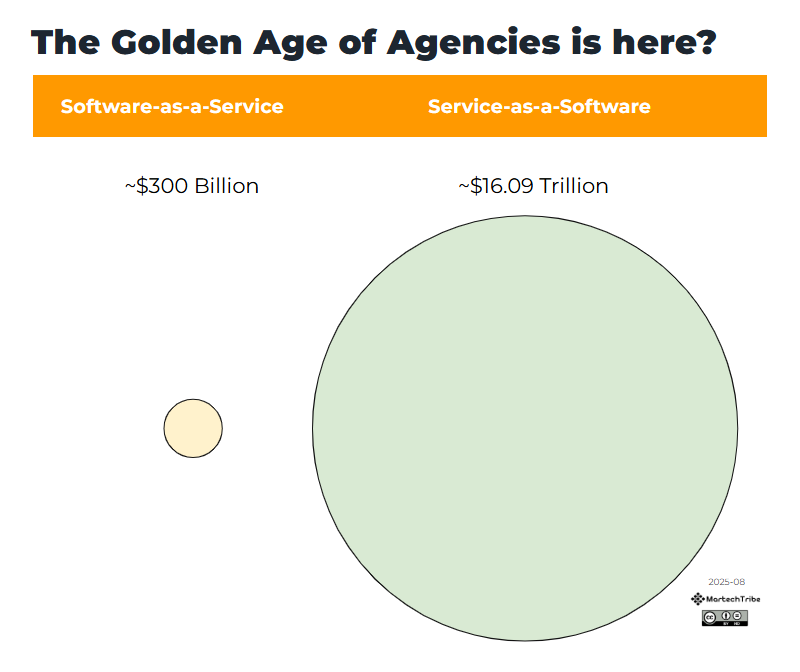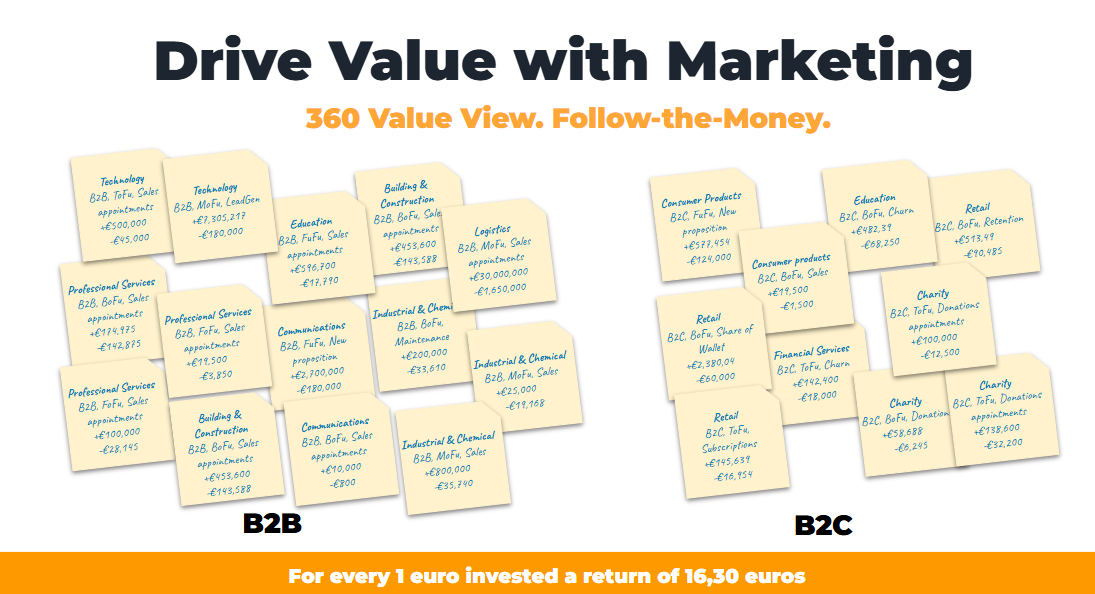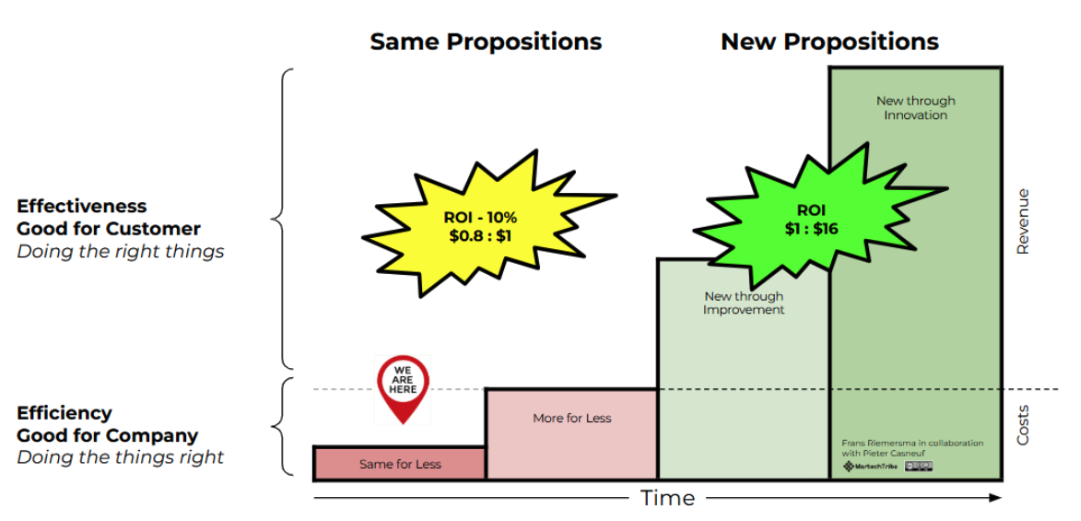.jpeg)
We found a way to navigate the 1,253 Commerce & Sales tools of the Martech Supergraphic. By analyzing 200+ real-life marketing technology stacks, we discovered that marketers in B2C mainly use Ecommerce platforms, whereas B2B marketers first invest in Sales Automation, followed by Sales Intelligence and finally Sales Enablement tooling.
This blog post on Commerce & Sales tools is part of a series. Other categories in the Martech Supergraphic are discussed in detail here:
- Ads & Promotions
- Content & Experience
- Social & Relationships
- Commerce & Sales - you found it!
- Data
- Management

4 Commerce & Sales ‘Jobs to be done’ are Key to Marketing Success
The Commerce & Sales category of the Supergraphic has one purpose: closing the deal. All previous stages transformed unaware anonymous web visitors into Marketing Qualified Leads. Now all efforts are focussed on getting Sales Qualified Leads (SQLs) to make their first purchase.
The subcategory names of the Martech Supergraphic are close to describing marketing tasks, processes or ‘jobs to be done’. They can be a starting point for learning to navigate the Supergraphic.

The individual tool names of the Martech Supergraphic can tell us which tools are dominant, and which of their capabilities are vital for running marketing/sales activities.

The list of tools in Commerce & Sales is a special one. First of all, the list is heavily leaning towards B2B. This is due to our Martech Stack research population. Also, one subcategory is by far the most popular: Sales Automation, Enablement & Intelligence.
The first 8 (in total 15 tools) of the top 20 tools fall in this subcategory. In our eyes, this overload justifies splitting this subcategory into three parts: Sales Automation, Sales Enablement and Sales Intelligence, which we did.
1a. Sales Automation
Introduction
B2B marketers first invest in Sales Automation tools. These tools help to automate and structure the sales process in general and support the follow up over multiple channels such as email, phone calls, video, audio and appointments.
The purpose of sales automation software is to boost sales productivity. Sales automation software should eliminate daily repetitive and time-consuming sales tasks in order to free up salespeople to focus on acquiring customers and closing deals.
Sales Automation tools support the productivity of sales representatives, who will be able to perform their job more efficiently. In concert with CRM and Marketing Automation tools, Sales Automation tools facilitate an improved sales workflow and aligned processes.
In this section, the dominant players are Salesloft, Outreach and Yesware. Salesloft supports sales people with email & dialer communication tools, as well as sales calls recording, coaching, and creating a meeting cadence by capturing, annotating, and analyzing meetings. Outreach supports closing deals by personalizing, prioritizing and analyzing sales activities. Yesware is a sales productivity platform providing email automation and sales prospecting campaign capabilities.
Pipedrive is a CRM/Sales management tool designed to help small sales teams manage their sales processes. Ringcentral belongs to this group too as it offers fax, video & audio messaging.
The most popular tool in this group is Docusign. It is a special creature as it helps sales reps to electronically sign documents and agreements, reducing the paperwork. The deal isn’t closed until the pixels of the digital signature are dry, so to speak. PandaDoc is a similar tool. As a document automation SaaS platform, it helps to create, send, and track documents, and enables management of electronic signatures (e-Signs), marketing-approved templates for proposals, contracts, and quotes.
1b. Sales Intelligence
Introduction
Sales Intelligence tools support the gathering of sales, customer and competitive insights that can be used by sales reps or teams to increase the chances of winning.
Sales Intelligence is focused on leveraging and mining sales data (CRM or 3rd party) for the purpose of finding undiscovered prospects with high potential.
Leandata, Insightsquared and Lattice leverage customer information through data analysis, predictive analytics, lead attribution and forecasting. Predictive analytics helps with analyzing current and historical data, statistical algorithms and machine-learning techniques to pick out patterns to make accurate predictions for the future. Lead attribution provides capabilities to evaluate campaign performance. This helps to focus on the right channels and properly assign marketing budgets.
We could add Kickfire to this section. They help sales to identify leads based on IP addresses and enrich the account data.
Datanyze and Hoovers enables the identification of sales leads in business information databases, where sales reps can search company profiles & gain rapid insights into market conditions.
These tools not only help enrich account data but also help build targeted prospect lists. With this in mind it borders on the subcategory of Audience/Marketing Data & Data Enhancement in the Data category. The latter covers the enrichment of account & prospect data.
1c. Sales Enablement
Introduction
Sales Enablement tools enable sales reps to customize and share content, such as customer presentations, relevant funnel-stage emails and product sheets, with customers. It also entails an internal sharing aspect, with files such as sales assets, playbooks, sales document templates for contracts, proposals and agreements.
Whereas Sales Automation and Intelligence tools are mostly sales territory-focused, Sales Enablement tools have stronger alignment with marketing. This is because as marketers provide funnel, or persona specific, relevant content into the sales funnel. It enables the sales reps to become micro marketers helping to push the sale.
Sales Enablement borders on Account Based Marketing (ABM) in the Social & Relationships category. Account Based Marketing (ABM), also known as Key Account Marketing (KAM), is the approach to engage with specific accounts in a personalized way. Providing relevant personalized content to the accounts is the core business of Sales Enablement.
Sales reps often do not have the relevant content they need. Yet, marketing creates three times more content than sales actually uses during the sales process. To improve the alignment and impact, sales teams need to be able to find, customize and share content quickly and easily. Marketing needs to be able to measure content usage and effectiveness to directly drive revenue.
In this field, four players rank high: Docurated, Savo, Seismic and Saleshood. These tools offer support in sales coaching, playbooks, sales assets, product info, sales document templates for contracts, proposals and agreements, newscenters, etc. All four use Artificial Intelligence (AI) to fuel their systems.
Docurated provides sales enablement and content management tools to ensure sales reps find the right piece of content to drive revenue. Savo supports sellers by helping them prepare for meetings and have effective customer conversations. AI technology enables guided selling, suggesting effective content for specific prospects and selling scenarios. Seismic is a B2B marketing and sales enablement tool that ensures account insights are never outdated, and sales assets are tailored to the right audience. SalesHood improves sales productivity by automating the sales process from coaching to closing. It supports using the right content at the right time and in the right context.
2. E-commerce platforms & Carts
Introduction
Mainly B2C marketers use E-commerce platforms & Carts to manage their online store. This software technology allows companies to build a storefront – a customer or business facing online shop – to sell products and/or services.
Despite the low number of B2C companies in our stack population, e-Commerce platforms are popular. E-commerce is concerned with the selling and purchasing of products online, such as clothes, shoes, apparel or software on an online platform.
Magento, Woocommerceand Shopify take the top ranks in the E-commerce area. Both Magento and Woocommerce are open-source e-commerce platforms.
Magento provides online merchants with a shopping cart system, as well as control over the look & feel, content and functionality of their online store. In addition, it offers marketing, search engine optimization and catalog-management capabilities for SMEs. Larger companies will integrate with the Product Information Management tools.
WooCommerce is an open-source customizable eCommerce platform offered in the form of a plugin for WordPress. It is developed for both small and large online merchants.
Shopify is a proprietary e-commerce platform for online stores and retail point-of-sale systems. The Shopify suite offers services such as payments, marketing, shipping and customer engagement to support the running of an online store for small merchants.
How to walk the four stages of Commerce & Sales ‘Jobs to be done’
To summarize…
- Automate the sales process and follow up with Sales Automation (1a)
- Equip sales reps with customer and competitive insights using Sales Intelligence (1b)
- Allow sales people to quickly customize and share content using Sales Enablement (1c)
- Build an attractive and effective online storefront with E-commerce platforms & Carts (2)
So, that is it for this Supergraphic category. If you are ready to get to grips with the next category, Data tools, stay tuned!

If you want to contribute to the ongoing Martech Benchmark research, submit your stack now. You’ll receive an automatically generated, personalized report in minutes.
Thanks to…
Lastly, a huge thank you to our magnificent and ever-growing review panel.Annika Werner, Carlos Doughty, Carmine Basil, Danielle Balestra, Doug Kessler, Hans van der Meulen, Huib Stad, Iban Rios, Julia Valentine, Kirsten Wildberger, Maarten Rijswijk, Marinka Eekman, Mark Wakelin, Matthieu Vermeulen, Mayer Becker, Mayur Soni, Michael Sweeney, Moni Oloyede, Nikki Kyriakopoulos, Odd Morten Sørensen, Peter Krmpotic, Peter Meijers, Rene Steiner, Roel Seegers, Samuel Schmitt, Scott Sweeney, Simon Daniels, Sree Vattikuti, Stacy Falkman, Travis Martin, Venkatesha(Venky) Murthy,Gary Katz, Marc Maisonneuve.
About this research
The Marketing Technology Landscape contains 7,040 tools spread over 50 subcategories, which are represented in the Martech Supergraphic. This is simply too much to take in. If we are not careful, marketers might think the field of martech is too complicated altogether, and might not capitalize on its huge potential.
In six blog posts, we’ll try to discover which stages companies usually go through as they improve their stack. We’ll explore which tools other companies are using, so you can identify how your company’s stack compares – where it overlaps and where gaps are. If you are over-equipped in a specific area, you might be able to cut out some tools and accompanying costs. And if you are under-equipped, you have a great opportunity to improve your marketing efforts.
If you are interested in how the martech market has developed over the years, including the data category, read all about Martech consolidation here.
When reading through the research results, please bear in mind that the sample is leaning towards SME B2B technology companies with between 25 to 1000 staff members and an annual turnover of 10 to 50 million dollars.
Want to contribute to the ongoing Martech Benchmark research? Submit your stack now.
Important note: We see our stack population of 200 Martech stacks as a first indicator for which type of tools marketers use or need. We aim to distill a ‘Martech roadmap’ that outlines which tools marketers need to improve their Martech capability over time, as their company develops.
Please understand that our research population is mainly covering SME B2B technology companies with between 25-1,000 staff members and yearly turnover of 10-50 million dollars. We believe our research population is still too small to consider our results as a definitive answer on which tools are best. Rather, we encourage you to investigate the breath of alternative tools within (sub)categories.




